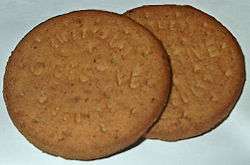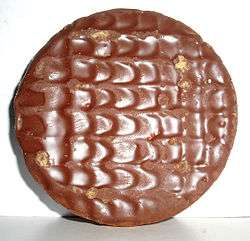Digestive biscuit
 | |
| Alternative names | Wheaten, sweet-meal biscuit |
|---|---|
| Type | Biscuit |
| Place of origin | Scotland |
| Main ingredients | Wheat flour, sugar, malt extract, vegetable oil, wholemeal, raising agents (usually sodium bicarbonate, tartaric acid and malic acid), salt |
|
| |
A digestive biscuit, sometimes described as a sweet-meal biscuit, is a semi-sweet biscuit (usually known in American English as a "cookie"[1]) that originated in the United Kingdom and is popular worldwide. The digestive was first developed in 1839 by two Scottish doctors to aid digestion.[2] The term "digestive" is derived from the belief that they had antacid properties due to the use of sodium bicarbonate when they were first developed.[3] Historically, some producers used diastatic malt extract to "digest" some of the starch that existed in flour prior to baking.[4][5]
History
In 1839, digestives were first developed in the United Kingdom by two Scottish doctors to aid digestion.[2] Digestives featured in advertisements for the Berkshire-based biscuit company Huntley & Palmers in 1876, with a recipe being given in Cassell's "New Universal Cookery Book" of 1894. In 1851 an issue of The Lancet London's advertising section offered brown meal digestive biscuits.[6] At the time, it was asserted grain millers knew only of bran and endosperm.[7] After 10% of the whole grain's coarser outer-bran coat was removed, and because the innermost 70% of pure endosperm was reserved for other uses, brown meal, representing only 20% of the whole grain, remained, consisting of about 15% fine bran and 85% white flour.[8] By 1912 it was more widely known that brown meal included the germ, which lent a characteristic sweetness.[9]
In 1889, John Montgomerie of Scotland filed a U.S. patent application, which was granted in 1890. This patent asserted a prior patent existed in England dated 1886. The U.S. patent, titled "Making Malted Bread", included instructions for the manufacture of digestive biscuits. Montgomerie claimed this saccharification process would make "nourishing food for people of weak digestion".[10]
Despite rumours that it is illegal for them to be sold under their usual name in the United States,[11] they are, in fact, widely available in imported food sections of grocery stores and by mail order.[12][13] In the US, buying digestive biscuits may require a visit to an international market, or they may be ordered from international retailers that have an Internet presence.[14]
Ingredients
The typical digestive biscuit contains coarse brown wheat flour (which gives it its distinctive texture and flavour), sugar, malt extract, vegetable oil, wholemeal, raising agents (usually sodium bicarbonate, tartaric acid and malic acid) and salt.[15] Dried whey, oatmeal, cultured skimmed milk and/or emulsifiers such as DATEM may also be added in some varieties.
A digestive biscuit averages around 70 calories, although this sometimes varies according to the factors involved in its production.
Nutrition
The average digestive biscuit contains 1.1g of protein, 9.4g of carbohydrates, 3.2g of fat (1.4g of which is saturated fat), 0.5g of fibre, 2.5g of sugar and 90 mg of sodium.[16]
Consumption
Digestive biscuits are frequently eaten with tea or coffee. Sometimes, the biscuit is dunked into the tea and eaten quickly due to the biscuit's tendency to disintegrate when wet. A digestive biscuit is in fact one on the top 10 biscuits in the United Kingdom for dunking in tea. The digestive biscuit is also used as a cracker with cheeses, and is often included in "cracker selection" packets.
In the UK, McVitie's digestive is the best selling biscuit, with 80 million packs sold annually.[3][17] Digestives are also popular in food preparation for making into bases for cheesecakes and similar desserts.[18]
Chocolate digestives

Chocolate digestive biscuits also are available, coated on one side with milk, dark or white chocolate. Originally produced by McVitie's in 1925 in the UK as the Chocolate Homewheat Digestive, other recent varieties include the basic biscuit with chocolate shavings throughout (chocolate "chips" within the biscuit mix), or a layer of caramel, mint chocolate, orange-flavoured chocolate,[19] or plain chocolate. American travel writer Bill Bryson described the chocolate digestive as "a British masterpiece".[20] The McVitie's chocolate digestive is the most popular biscuit in the UK to dunk into tea.[2]
Recipe substitution
In recipes calling for digestive biscuits, the closest available in the United States is Carr's Whole Wheat Cracker. According to Charles Panati, the original graham cracker is called a "digestive biscuit" in the United Kingdom.[21] However, graham crackers are typically a little dryer and more brittle.
In popular culture
McVitie’s Digestive Biscuits have become known among fans of the rock group The Beatles because they were the cause of an argument between George Harrison and John Lennon during a recording session for the group's 1969 album Abbey Road. The incident was recounted by recording engineer Geoff Emerick in his book Here, There, and Everywhere: My Life Recording the Music of The Beatles (Gotham Books, ISBN 1-59240-179-1), co-authored by veteran music journalist Howard Massey. According to Emerick, Lennon's wife Yoko Ono was in the recording studio and at one point helped herself to Harrison's box of McVitie's while the Beatles were in the control room listening to a playback of the song they'd just recorded. Harrison got angry at Ono, and his subsequent outburst caused Lennon to lose his temper in response.[22]
See also
References
- ↑ Roller, Sibel (1996). Handbook of fat replacers. Boca Raton, Fla: CRC Press. p. 52. ISBN 1-4200-4897-X. Retrieved 2013-12-26.
U.K. digestive biscuit market
- 1 2 3 "Chocolate digestive is nation's favourite dunking biscuit". The Telegraph. May 2, 2009
- 1 2 "United Biscuits — McVitie's Brand History".
- ↑ Chamber's encyclopaedia: a dictionary of universal knowledge, Volume 2. J.B. Lippencott Company. 1888. p. 182. Retrieved 2011-04-07.
Digestive biscuits are prepared in such a manner that they may contain diastase, the nitrogenous transforming matter of malt; but whatever quantity of this substance they may contain in the condition of dough is destroyed in the process of baking.
- ↑ Pharmaceutical journal and Transactions. Third. XVII. London. 1887. p. 156. Retrieved 2011-04-08.
A new competitor in this field was Paterson's Extract of Malt, exhibited by the Phoenix Chemical Works, Glasgow; the odour and flavour of this was excellent, and it is said to be rich in diastasic power. Prepared from it was exhibited a series of digestive biscuits, rusks and bread by John Montgomerie, of Glasgow. In making these part of the starch of the flour is changed by being mixed with the malt extract and water and kept for some time at a suitable temperature; the yeast being probably added to another portion of flour and water, to form dough to mix with the above before baking. These biscuits seemed to be appreciated by visitors. Messrs. Hill and Son also exhibited some malted nursery biscuits. Benger's well known digestive ferments were well displayed, together with an essence of rennet recently introduced.
- ↑ Thomas Wakely, ed. (July 31, 1851). The Lancet [A Journal of British and Foreign medicine, Physiology, Surgery, Chemistry, Criticism, Literature, and News]. 2. London: George Churchill. pp. 24(IA2)–24(IA3). Retrieved 2011-04-01.
- ↑ John Saunders, ed. (1848). The People's journal. IV. London: The People's Journal Office. p. 42(IA1). Retrieved 2011-04-15.
Professor Johnston remarks that -- "The grain of wheat consists of two parts, with which the miller is familiar -- the inner grain and the skin that covers it. The inner grain gives the pure wheat flour; the skin when separated, forms the bran."
- ↑ Bell, Jacob, ed. (1857–58). The Pharmaceutical journal and Transactions. XVII. John Churchill. pp. 276–277.
The Parisian white bread is prepared with the finest flour (1re marque), which does not contain any bran. If 100 parts wheat yield 70 parts of this flour, the remainder will consist of 10 parts bran and 20 parts coarse brown meal, this latter consisting of 3 parts fine bran and 17 parts white flour.
- ↑ Percy A. Amos (1912). Processes of flour manufacture. Longman, Green, and Co. p. 14.
By allowing the germ and all but the outer, coarser layers of broad bran to mix in with the flour, we get the sweet-tasting brown meal producing the brown bread so much in favour amongst sections of the community.
- ↑ U.S. Patent 423,263
- ↑ QI, Season B, Episode 7, "Biscuits", In America it is illegal to call them "digestives"
- ↑ Cost Plus World Market: Product listing for retail and mail order availability in the United States
- ↑ Smith, Andrew (2013). The Oxford encyclopedia of food and drink in America. New York, NY: Oxford University Press. p. 168. ISBN 0-19-973496-8. Retrieved 2013-12-28.
Digestive biscuits, semi-sweet and made with brown meal, can no longer be made under that name in the United States, but the English version is widely available.
- ↑ Luther, Carol. "What are Digestive Biscuits?". Livestrong.com. Retrieved 10 December 2011.
- ↑ Young, Linda; Cauvain, Stanley P. (2006). Baked Products: Science, Technology and Practice. Wiley-Blackwell. p. 62. ISBN 1-4051-2702-3. Retrieved 2011-04-08.
- ↑ Calories in a Digestive Biscuit sparkpeople.com
- ↑ "Crumbs, we've been eating McVitie's Digestives and Hobnobs all wrong! Firm says chocolate part is the BOTTOM". Daily Mail. Retrieved 28 December 2014
- ↑ Waitrose: Banoffee Pie
- ↑ EnglishTeaStore.com: McVities Milk Chocolate & Orange Digestives 300g Accessed 2008-01-05
- ↑ Bryson, Bill. (1996). Notes from a Small Island; William Morrow, ISBN 0-688-14725-9
- ↑ Panati, Charles (1989). Panati's extraordinary origins of everyday things. San Francisco: Perennial Library. p. 413. ISBN 0-06-096419-7. Retrieved 2011-04-08.
The graham cracker originated as a health food, and in Britain it is still known as a "digestive biscuit."
- ↑ https://books.google.com/books?id=WOk8TP8o018C&pg=PT309&lpg=PT309&dq=mcvities+digestive+george+john+beatles&source=bl&ots=zoO8XK2XSK&sig=Z3hgKUNcUjuZhanIjrqaYtD1J_U&hl=en&sa=X&ved=0ahUKEwjS3unb_pvOAhUDyyYKHSjMBxgQ6AEIUjAI#v=onepage&q=mcvities%20digestive%20george%20john%20beatles&f=false
Bibliography
- Emerick, Geoff; Massey, Howard (2006). Here, There and Everywhere My Life Recording the Music of The Beatles. New York: Penguin Books. ISBN 978-1-59240-179-6.
External links
![]() Media related to Digestive biscuits at Wikimedia Commons
Media related to Digestive biscuits at Wikimedia Commons